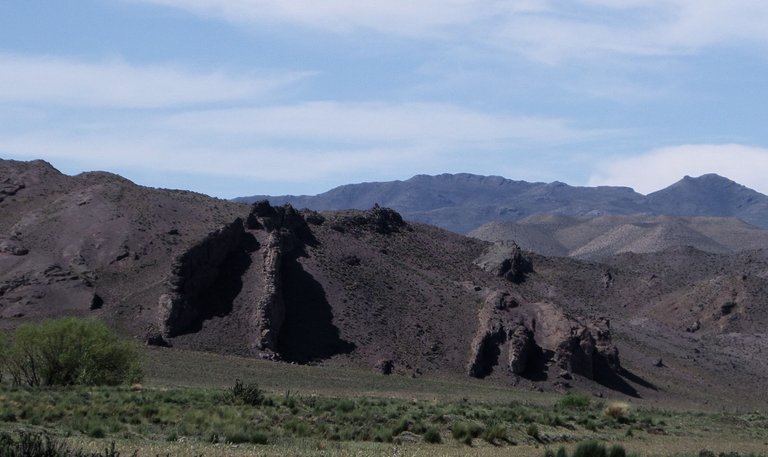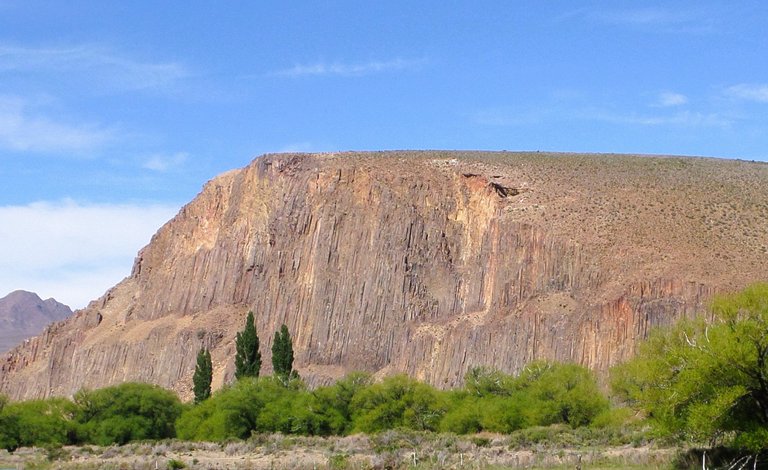Mi nombre es Horacio y esta es mi primera publicación en Hive. Mi nickname apunta a mi afición por la pesca con mosca.
Ingresé al blog por recomendación de mi amigo @hosgug quien insistió mucho para que me incorporara, finalmente acepté y aquí estoy, aunque él se encargó de todo el tema de la registración y otras cosas que me explicó varias veces, nunca entendí lo suficiente o no me animé a dar el paso por mí mismo.
Se puede decir que soy un geólogo inconcluso, de joven me interesó siempre este tema y hasta me inscribí en la facultad de ciencias exactas de la universidad de Buenos Aires donde se estudia la carrera, pero pronto me di cuenta que la base matemática, física y química que hacía falta para transitar con comodidad por ese fascinante mundo no la tenía en aquel momento y abandoné al poco tiempo.
Pero al venir a vivir a este lugar lleno de montañas, accidentes geográficos de toda índole y una historia geológica admirable, poco a poco la emoción por saber más del tema comenzó a formarse en mi mente. Desde entonces he leído, estudiado y explorado el fascinante mundo de las rocas y sus formaciones, por supuesto como aficionado y sin pretensiones de ningún tipo, solo para satisfacer mi propia necesidad de conocimientos y paliar en parte aquella frustración juvenil.
Pasamos junto a mi amigo tres días de pesca y turismo en inmediaciones de un pequeño pueblo de la estepa patagónica llamado Gualjaina, ubicado al este de Esquel, mi ciudad de residencia, bastante cercana, por cierto.
En nuestro caminar en busca de buenos lugares para practicar nuestra actividad favorita observamos diversas formaciones rocosas, por supuesto abundan las rocas ígneas que los diferentes procesos geológicos han transportado y depositado en la superficie terrestre, casi todas ellas son extrusivas, es decir magma que aflora a la superficie y se enfría con rapidez, justamente esa velocidad de enfriamiento no permite que se formen cristales grandes pero si pequeños, hay algunas variedades que se diferencian por su composición química, siendo las félsicas y las andesíticas la predominante en esta zona. También se las puede clasificar por su textura y formas, tenemos por ejemplo la piedra pómez, la obsidiana y el basalto, esta última la más común.
He comprobado que algunas rocas extrusivas poseen formas curiosas que la imaginación humana asimila y compara con objetos y animales, dotando al paisaje de formas y colores que atraen a las personas como por ejemplo el famoso “Valle Encantado”, una zona cercana a la turística ciudad de Bariloche donde varias formaciones de rocas volcánicas tienen nombres que representan el parecido de la formación con algo específico, por ejemplo “El dedo de Dios”, una formación natural de varios metros de altura que se asemeja a un dedo índice apuntando hacia el cielo. La “Montura Chilena”, el “Fotógrafo”, el “Trencito” y el “Centinela del Valle” son otras formaciones que fueron bautizadas con esos nombres por sus particulares formas.
Aquí en esta zona también hay variadas formaciones que se asemejan a objetos y animales, aunque por estar alejada de los circuitos turísticos tradicionales, no tienen nombre o son desconocidas para la mayoría de las personas que pasan por el lugar.
Retratamos algunas de ellas e imaginamos un tobogán, el conocido juego para niños que hay en parques y plazas, a su lado una enorme garra de león se observa a simple vista.
Otra formación que llamó nuestra atención fue la ladera de un pequeño cerro llena de columnas probablemente formaciones de lajas. Según me han comentado, algunos se han llevado partes de esas columnas para decorar el interior de sus hogares.
Solo observamos unos minutos y tomamos estas fotografías que acompañan la nota. Más lejos se divisaba una formación que asemejaba la cabeza de un pequeño perro con largas orejas, como un pekinés o quizás un Shih-Tzú. Estábamos muy alejados y aunque tomamos algunas fotografías tanto la luz como la distancia no nos permitieron una buena toma, quedará como tarea para la próxima vez.
Prepararé más material sobre estos temas, los que espero sean de vuestro interés.
Looking at the rocks
My name is Horacio and this is my first post on Hive. My nickname points to my love of fly fishing.
I entered the blog on the recommendation of my friend @hosgug who insisted a lot for me to join, finally I accepted and here I am, although he took care of the whole registration issue and other things that he explained to me several times, I never understood enough or not I was encouraged to take the step for myself.
It can be said that I am an unfinished geologist, when I was young I was always interested in this subject and I even enrolled in the Faculty of Exact Sciences at the University of Buenos Aires where I studied for my degree, but I soon realized that the mathematical, physical and The chemistry that was needed to move comfortably through this fascinating world I did not have at that time and I left after a short time.
But when I came to live in this place full of mountains, geographical accidents of all kinds, and an admirable geological history, little by little the emotion to know more about the subject began to form in my mind. Since then I have read, studied and explored the fascinating world of rocks and their formations, of course as an amateur and without pretensions of any kind, just to satisfy my own need for knowledge and alleviate some of that youthful frustration.
We spent with my friend three days of fishing and tourism in the vicinity of a small town in the Patagonian steppe called Gualjaina, located east of Esquel, my city of residence, quite close, by the way.
In our walk in search of good places to practice our favorite activity we observe various rock formations, of course, there are many igneous rocks that the different geological processes have transported and deposited on the earth's surface, almost all of them are extrusive, that is, magma that outcrops at the surface and cools quickly, precisely that cooling rate does not allow large crystals to form but small ones, there are some varieties that differ in their chemical composition, with felsic and andesitic being the predominant in this area. They can also be classified by their texture and shapes, we have for example pumice stone, obsidian, and basalt, the latter being the most common.
I have verified that some extrusive rocks have curious shapes that the human imagination assimilates and compares with objects and animals, giving the landscape shapes and colors that attract people, such as the famous "Enchanted Valley", an area near the tourist city of Bariloche where several volcanic rock formations have names that represent the similarity of the formation with something specific, for example, “El Dedo de Dios”, a natural formation several meters high that resembles an index finger pointing towards the sky. The "Chilean Mount", the "Photographer", the "Trencito" and the "Centinela del Valle" are other formations that were baptized with those names due to their particular shapes.
Here in this area, there are also various formations that resemble objects and animals, although being far from the traditional tourist circuits, they have no name or are unknown to most of the people who pass through the place.
We photographed some of them and imagined a slide, the well-known children's game that is found in parks and squares, next to it a huge lion's claw can be seen with the naked eye.
Another formation that caught our attention was the slope of a small hill full of columns, probably slab formations. As I have been told, some have taken parts of these columns to decorate the interior of their homes.
We only observed for a few minutes and took the photographs that accompany the note. Further away was a formation that resembled the head of a small dog with long ears, like a Pekingese or perhaps a Shih-Tzú. We were very far away and although we took some photographs, both the light and the distance did not allow us to take a good shot, it will be a task for the next time.
I will prepare more material on these topics, which I hope will be of interest to you.



Hola querido amigo @onlyfly, me suena un poco extraño llamarte así luego de tantos años, pero en Hive todos nos mencionamos por nuestro nickname.
Me alegra profundamente que hayas por fin decidido a dar el primero de lo que supongo muchos pasos dentro de la colmena. Conozco tu pasión por estos temas y estoy seguro aportarás mucho más de tus conocimientos y exploraciones.
Bienvenido y vamos por más.
Congratulations @onlyfly! You have completed the following achievement on the Hive blockchain and have been rewarded with new badge(s):
Your next target is to reach 50 upvotes.
You can view your badges on your board and compare yourself to others in the Ranking
If you no longer want to receive notifications, reply to this comment with the word
STOPSupport the HiveBuzz project. Vote for our proposal!
Hey @onlyfly! This is @indayclara from the @ocd team. Congratulations and welcome to Hive!
Quite the adventurer you are! Hope we can read more of your travels and amazing finds here. Here are some communities you might like: Amazing Nature, Outdoors and more, and Pinmapple.
Starting your journey here on Hive can be overwhelming so it's good to do your research and ask around. You can also read: How To Get A Great Start on the Hive Blockchain.
Some things to remember here on Hive:
We wish you all the best in your Hive journey!
Thank you very much for your welcome, recommendations and advice!